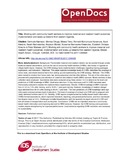| dc.contributor.author | Namazzi, G. | |
| dc.contributor.author | Okuga, M. | |
| dc.contributor.author | Tetui, M. | |
| dc.contributor.author | Kananura, R.M. | |
| dc.contributor.author | Kakaire, A. | |
| dc.contributor.author | Namutamba, S. | |
| dc.contributor.author | Mutebi, A. | |
| dc.contributor.author | Kiwanuka, S.N. | |
| dc.contributor.author | Ekirapa-Kiracho, E. | |
| dc.contributor.author | Waiswa, P. | |
| dc.coverage.spatial | Uganda | en |
| dc.date.accessioned | 2017-10-03T15:18:39Z | |
| dc.date.available | 2017-10-03T15:18:39Z | |
| dc.date.issued | 2017-08-29 | |
| dc.identifier.citation | Namazzi, G., Okuga, M., Tetui, M., Muhumuza Kananura, R., Kakaire, A., Namutamba, S., Mutebi, A., Namusoke Kiwanuka, S., Ekirapa-Kiracho, E. and Waiswa, P., 2017. Working with community health workers to improve maternal and newborn health outcomes: implementation and scale-up lessons from eastern Uganda. Global Health Action, 10(sup4), p.1345495. | en |
| dc.identifier.uri | https://opendocs.ids.ac.uk/opendocs/handle/20.500.12413/13253 | |
| dc.description.abstract | Background: Preventable maternal and newborn deaths can be averted through simple evidence-based interventions, such as the use of community health workers (CHWs), also known in Uganda as village health teams. However, the CHW strategy faces implementation challenges regarding training packages, supervision, and motivation. Objectives: This paper explores knowledge levels of CHWs, describes the coverage of home visits, and shares lessons learnt from setting up and implementing the CHW strategy. Methods: The CHWs were trained to conduct four home visits: two during pregnancy and two after delivery. The aim of the visits was to promote birth preparedness and utilization of maternal and newborn health (MNH) services. Mixed methods of data collection were employed. Quantitative data were analyzed using Stata version 13.0 to determine the level and predictors of CHW knowledge of MNH. Qualitative data from 10 key informants and 15 CHW interviews were thematically analyzed to assess the implementation experiences. Results: CHWs’ knowledge of MNH improved from 41.3% to 77.4% after training, and to 79.9% 1 year post-training. However, knowledge of newborn danger signs declined from 85.5% after training to 58.9% 1 year later. The main predictors of CHW knowledge were age (≥ 35 years) and post-primary level of education. The level of coverage of at least one CHW visit to pregnant and newly delivered mothers was 57.3%. Notably, CHW reports complemented the facility-based health information. CHWs formed associations, which improved teamwork, reporting, and general performance, and thus maintained low dropout rates at 3.6%. Challenges included dissatisfaction with the quarterly transport refund of 6 USD and lack of means of transportation such as bicycles. Conclusions: CHWs are an important resource in community-based health information and improving demand for MNH services. However, the CHW training and supervision models require strengthening for improved performance. Local solutions regarding CHW motivation are necessary for sustainability. | en |
| dc.description.sponsorship | DFID | en |
| dc.language.iso | en | en |
| dc.publisher | Taylor & Francis Open | en |
| dc.relation.ispartofseries | Global Health Action;10:Supplement 4 | |
| dc.rights.uri | http://creativecommons.org/licenses/by/4.0/ | en |
| dc.subject | Gender | en |
| dc.subject | Health | en |
| dc.title | Working with Community Health Workers to Improve Maternal and Newborn Health Outcomes: Implementation and Scale-Up Lessons from Eastern Uganda | en |
| dc.type | Article | en |
| dc.rights.holder | Taylor & Francis Group | en |
| dc.identifier.externaluri | http://www.tandfonline.com/doi/full/10.1080/16549716.2017.1345495 | en |
| dc.identifier.team | Health and Nutrition | en |
| dc.identifier.doi | 10.1080/16549716.2017.1345495 | |
| dcterms.dateAccepted | 2017-06-19 | |
| rioxxterms.funder | Default funder | en |
| rioxxterms.identifier.project | Future Health Systems | en |
| rioxxterms.version | NA | en |
| rioxxterms.versionofrecord | 10.1080/16549716.2017.1345495 | en |
| rioxxterms.funder.project | 50c0b576-b4b1-402e-a6cd-50d73c1d4430 | en |


